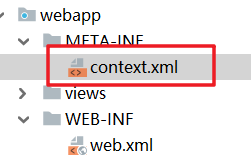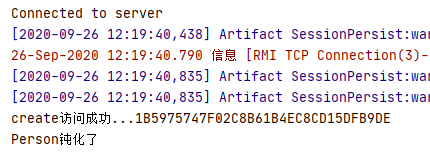面試官:講講session的持久化
一、session知識回顧
1.1 session何時建立?
預設第一次存取時,使用到了HttpSession就會建立(request.getSession),存取JSP時由於會自備九大內建物件,因此也會建立session
1.2 session何時銷燬?
1):當session存活時間到期時銷燬(預設30分鐘)
可以在web.xml中設定,延長session的存活時間:
<session-config>
<!-- 單位:分鐘 -->
<session-timeout>30</session-timeout>
</session-config>
2):呼叫session的invalidate()方法時銷燬
3):呼叫session.setMaxInactiveInterval()方法時間到期時銷燬(此方法單位為分鐘)
4):伺服器關閉,session銷燬
二、session如何持久化?
2.1 概念
使用session的鈍化與活化可以使session進行磁碟的持久化
鈍化後可以儲存到磁碟,檔名為:sessionid.session,下次使用者端存取原來的對談(伺服器關閉之前的)只要帶上原來的sessionid即可把上一次的對談找回來(活化)

session鈍化後,如果遇到session.invalidate(),session.setMaxInactiveInterval()時間到期,鈍化的檔案會自動刪除。
2.2 程式碼實現session持久化
1)建立一個web專案
- 依賴:
<dependency>
<groupId>org.apache.tomcat</groupId>
<artifactId>tomcat-api</artifactId>
<version>8.5.41</version>
</dependency>
2)在web專案中新增如下設定:

<Context>
<!-- maxIdleSwap:session中的物件多長時間不使用就鈍化(單位為分鐘) -->
<!-- directory:鈍化後的物件的檔案寫到磁碟的哪個目錄下 設定鈍化的物件檔案在work/catalina/localhost/鈍化檔案 -->
<Manager className="org.apache.catalina.session.PersistentManager" maxIdleSwap="1">
<Store className="org.apache.catalina.session.FileStore" directory="d:/aaa" />
</Manager>
</Context>
3)編寫鈍化類
要使session儲存的物件能鈍化和活化必須實現HttpSessionAcivationListener介面,要能將物件儲存到硬碟上必須實現Serializable介面
package com.lscl.entity;
import javax.servlet.http.HttpSessionActivationListener;
import javax.servlet.http.HttpSessionEvent;
import java.io.Serializable;
/**
* 要使session儲存的物件能鈍化和活化必須實現HttpSessionAcivationListener介面
* 要能將物件儲存到硬碟上必須實現Serializable介面
*/
public class Person implements HttpSessionActivationListener, Serializable {
private String id;
private String name;
public Person() {
}
public Person(String id, String name) {
this.id = id;
this.name = name;
}
public String getId() {
return id;
}
public void setId(String id) {
this.id = id;
}
public String getName() {
return name;
}
public void setName(String name) {
this.name = name;
}
//鈍化時執行的方法
public void sessionWillPassivate(HttpSessionEvent se) {
// TODO Auto-generated method stub
System.out.println("Person鈍化了");
}
//活化時執行的方法
public void sessionDidActivate(HttpSessionEvent se) {
// TODO Auto-generated method stub
System.out.println("Person活化了");
}
@Override
public String toString() {
return "Person{" +
"id='" + id + '\'' +
", name='" + name + '\'' +
'}';
}
}
- 建立session:
package com.lscl.servlet;
import com.lscl.entity.Person;
import javax.servlet.ServletException;
import javax.servlet.annotation.WebServlet;
import javax.servlet.http.HttpServlet;
import javax.servlet.http.HttpServletRequest;
import javax.servlet.http.HttpServletResponse;
import java.io.IOException;
@WebServlet("/create")
public class CreateServlet extends HttpServlet {
@Override
protected void service(HttpServletRequest req, HttpServletResponse resp) throws ServletException, IOException {
System.out.println("create存取成功..."+req.getSession().getId());
Person person=new Person("1","張三");
// 將物件存入session
req.getSession().setAttribute("person",person);
}
}
- 查詢session:
package com.lscl.servlet;
import javax.servlet.ServletException;
import javax.servlet.annotation.WebServlet;
import javax.servlet.http.HttpServlet;
import javax.servlet.http.HttpServletRequest;
import javax.servlet.http.HttpServletResponse;
import java.io.IOException;
@WebServlet("/query")
public class QueryServlet extends HttpServlet {
@Override
protected void service(HttpServletRequest req, HttpServletResponse resp) throws ServletException, IOException {
System.out.println("query存取成功..."+req.getSession().getId());
System.out.println(req.getSession().getAttribute("person"));
}
}
- 刪除session:
package com.lscl.servlet;
import javax.servlet.ServletException;
import javax.servlet.annotation.WebServlet;
import javax.servlet.http.HttpServlet;
import javax.servlet.http.HttpServletRequest;
import javax.servlet.http.HttpServletResponse;
import java.io.IOException;
@WebServlet("/delete")
public class DeleteServlet extends HttpServlet {
@Override
protected void service(HttpServletRequest req, HttpServletResponse resp) throws ServletException, IOException {
System.out.println("delete存取成功..."+req.getSession().getId());
// 銷燬session(鈍化的檔案也會被刪除)
req.getSession().invalidate();
}
}
2.3 測試session的持久化
1)存取地址:http://localhost:8080/create建立session,並等1分鐘(等待session鈍化)

檢視session檔案:

2)重新啟動伺服器(session銷燬),存取http://localhost:8080/query,檢視控制檯資訊

發現伺服器重新啟動之後(session銷燬),對談中的資料依舊能夠找回來;
- 這裡說一點,伺服器重新啟動後,是session銷燬了,並不是cookie(sessionid)銷燬了,cookie依舊儲存在前端瀏覽器,只要cookie沒有銷燬,前端依舊帶的是上傳的對談id來到後臺
我們換個瀏覽器,存取http://localhost:8080/query,發現sessionid又是新的了,此時伺服器又會建立一個新的session

3)存取http://localhost:8080/delete,發現session檔案被刪除了
三、總結一下
-
session的持久化:session的持久化分為鈍化與活化,將session中的內容持久化到磁碟稱為鈍化,鈍化後的session會永久儲存在磁碟中,當session銷燬時,.session檔案也會被刪除
-
被持久化的物件必須實現
HttpSessionAcivationListener和Serializable介面 -
我們平時關閉瀏覽器之後,session的對談資訊查詢不到了並不是session銷燬了,而是前端的cookie銷燬了,此cookie上儲存了上次對談的id,存取後臺時,會自動帶上,如果後臺發現沒有帶上sessionid則建立一個新的session,並將此session的id寫回前端,前端儲存到cookie上;至於session何時銷燬,文章開篇已經說了